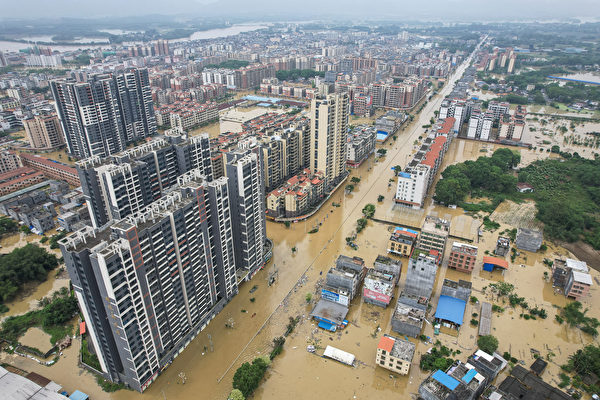Recent severe floods in Guangdong have led to multiple casualties. On April 23rd and 24th, the Yangtze River Flood Control Headquarters and the Yellow River Conservancy Commission respectively stated that there might be significant flooding in the middle and lower reaches of the Yangtze River and in the middle and lower reaches of the Yellow River during this flood season.
According to mainland media reports, on the 24th, the Yellow River Conservancy Commission of the Ministry of Water Resources of the Chinese Communist Party announced that the rainfall in the middle and lower reaches of the Yellow River Basin is expected to be 2-5% above normal during this flood season, which could result in major flooding. They also emphasized that the anomalies and uncertainties of the coexistence of droughts and floods and the rapid changes have significantly increased.
On the 23rd, the Yangtze River Flood Control and Drought Resistance Headquarters stated that heavy rains are expected to dominate over droughts in the Yangtze River basin during this flood season. The middle and lower reaches of the Yangtze River, Dongting Lake, Poyang Lake, and the northern parts of the two lakes’ water systems might experience significant floods. Due to uneven distribution of precipitation, a situation of simultaneous droughts and floods is expected to occur.
During the main flood season from June to August, the precipitation in the upper reaches of the Yangtze River is forecasted to be 5%-10% above normal, with the middle and lower reaches possibly experiencing over 10% excess rainfall, and the precipitation near the middle stream of the Yangtze might exceed 20% above normal.
Apart from the potential floods in the middle and lower reaches of the Yangtze River and the Dongting Lake and Poyang Lake water systems, there is also a risk of temporary drought in the middle and lower reaches of the Jinsha River, with the possibility of rapid shifts from floods to droughts.
It is anticipated that from April 24th to 25th, there will be a process of “moderate rain and locally heavy rain” moving from west to east in the southern part of the Yangtze River main stream; starting from the 28th, a new round of precipitation is expected to begin in the Yangtze River basin.
On the 23rd, the Taihu Lake Basin Authority stated that in the southeast part of the Taihu Lake Basin, most river basins are forecasted to receive 2-5% more precipitation than usual. The southern part of Qiantang River Basin and the northern part of the Min River and other rivers are expected to have 1-2% more rainfall than normal. The precipitation pattern during the flood season in the Taihu Lake Basin exhibits a “more in the north, less in the south” characteristic, significantly impacted by typhoons, resulting in many days of high temperatures.
However, these authorities have not provided specific defense measures nor reminded the public of specific precautions.
Before these warnings were issued, from April 19th to 21st, heavy rains hit multiple areas in Guangdong, causing severe floods in Shaoguan, Qingyuan, and Zhaoqing. On the 22nd, official reports stated that three people died in Zhaoqing, one in Shaoguan, and there are still 10 missing persons in Shaoguan, Qingyuan, and other areas. A total of 110,000 people have been relocated in the province, with 25,800 people being urgently relocated. Videos circulating online show that floodwaters have submerged the ground floors of buildings and washed away vehicles, indicating the severity of the disaster, prompting doubts about the accuracy of the official data provided by the Chinese Communist Party.
Regarding the cause of the floods, many people suspect that the extensive flood discharge is related, believing that the authorities are prioritizing protecting downstream areas like Guangzhou, leading to massive flood discharge from reservoirs.
Renowned hydraulic expert Wang Weiluo previously told Epoch Times that the risks of dam breaches are a major concern for the Chinese Communist Party. During the flood season, they open floodgates regardless, focusing solely on the safety of large dams without considering the safety issues and property losses that opening dams may pose to the people.

